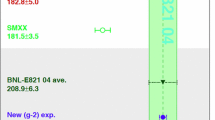Abstract
Muon capture on hydrogen gives a unique possibility for a measurement of the pseudo-scalar form factor g p (q 2c = -0.88 m 2μ ) of the nucleonic weak current, thus providing a sensitive test of the QCD chiral symmetry perturbation theory which predicts the value of this form factor with a precision of Δg p /g p ≃ 2%. For adequate comparison with theory, the muon capture rate Λc should be measured with a precision of ΔΛc/Λc ≤ 1%, that is an order of magnitude better than the precision of the present world data. We report on the project of an experiment designed to provide the required precision. Also, we present the final result of our previous experiment on a high precision measurement of the μ3He capture rate and compare this result with the PCAC prediction.
Similar content being viewed by others
References
P. Ackerbauer et al., Phys. Lett. B 417 (1998) 224.
C.W. Kim and H. Primakoff, Phys. Rev. B 140 (1965) 566.
J.G. Congleton and H.W. Fearing, Nucl. Phys. A 552 (1993) 534.
J.G. Congleton and E. Truhlik, Phys. Rev. C 53 (1996) 956.
V. Bernard et al., Phys. Rev. D 50 (1994) 6899.
H.W. Fearing et al., Phys. Rev. D 56 (1997) 1783.
R. Hildebrand, Phys. Rev. Lett. 8 (1962) 34.
E.J. Bleser et al., Phys. Rev. Lett. 8 (1962) 288.
E. Bertolini et al., in: Proc. Int. Conf on High Energy Physics, Geneva (1962).
J.E. Rothberg et al., Phys. Rev. 132 (1963) 2664.
A. Alberigi Quaranta et al., Phys. Rev. 177 (1969) 2118.
V.M. Bystritskii et al., Sov. Phys. JETP 40 (1974) 811.
G. Bardin et al., Nuclear Phys. A 352 (1981) 365.
G. Bardin et al., Phys. Lett. 104 B (1981) 320.
G. Jonkmans et al., Phys. Rev. Lett. 77 (1996) 4512.
I.V. Falomkin et al., Phys. Lett. 3 (1963) 229.
L.B. Auerbach et al., Phys. Rev. B 138 (1965) 127.
D.B. Clay et al., Phys. Rev. B 140 (1965) 586.
N.C. Mukhopadhyay and K. Junker, Phys. Rev. Lett. 27 (1996).
D.V. Balin et al., PSI Proposal R-97-05.1 (1997).
T.J. Chapin et al., Nucl. Instrum. Methods 197 (1982) 305.
V.A. Andreev et al., Preprint PNPI-1142 (1985).
Author information
Authors and Affiliations
Rights and permissions
About this article
Cite this article
Vorobyov, A., Ackerbauer, P., Adamczak, A. et al. Final results on the μ3He-capture experiment and perspectives for μ p-capture studies. Hyperfine Interactions 118, 13–24 (1999). https://doi.org/10.1023/A:1012616015304
Issue Date:
DOI: https://doi.org/10.1023/A:1012616015304




